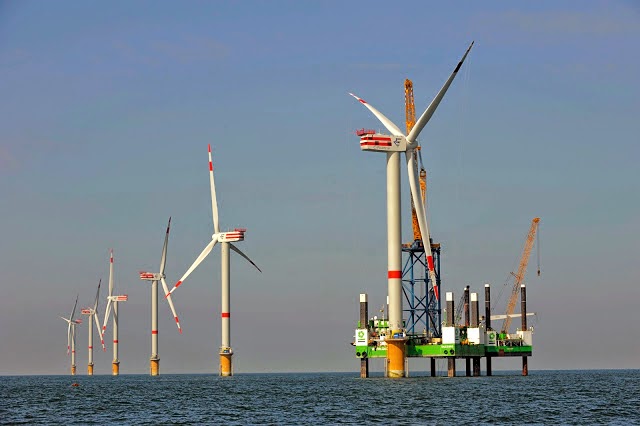En el área de las energías renovables, Iberdrola ha puesto en marcha a lo largo de 2014 proyectos que promueven soluciones para reducir los costes de la energía eólica offshore, ámbito en el que Iberdrola ya es un referente, al haber sido la primera empresa española en poner en marcha una instalación de estas características en el mundo: el complejo de West of Duddon Sands, en Reino Unido.
Dentro de estas iniciativas hay que destacar el proyecto de cimentaciones de gravedad LOW-IMPACT, el proyecto LEANWIND de tecnologías offshore y las diferentes líneas de actuación del ambicioso programa OWA (Offshore Wind Accelerator), promovido por el Carbon Trust del Reino Unido.
En Escocia ha comenzado un estudio de fatiga en pilotes offshore para suelos calcáreos, de forma que se optimicen diseños y se asegure su estabilidad. Igualmente, ha participado en el proyecto TLPWind, que persigue crear un modelo de aerogenerador flotante de última generación y un innovador sistema de instalación asociado para fomentar la puesta en marcha de parques offshore en zonas de Reino Unido donde ahora no es viable por la profundidad de las aguas. Además, Iberdrola ha lanzado el proyecto europeo BEST PATH, cuyo objetivo es la demostración de nuevas tecnologías que faciliten la integración de renovables en las redes europeas y el proyecto SMARTWIND, que investiga sobre modelos y simulaciones de tecnología de almacenamiento asociado a parques eólicos.
Iberdrola y la empresa sueca especializada en energías marinas CorPower ha realizado en Estocolmo una demostración de su proyecto internacional de innovación HiWave, que ya encara la fase final de construcción del prototipo de energía de las olas a escala real.
Durante el evento, Iberdrola y CorPower han mostrado las principales características de esta vanguardista boya, una de las que más futuro tiene dentro del sector de la generación eléctrica a través de esta fuente de energía.
La jornada se inició con una visita a la isla de Tynningö, en el archipiélago de Estocolmo, en donde se ha mostrado el comportamiento en agua de la boya a escala 1:16, de aproximadamente un metro de altura. También se pudo ver el taller del inventor de este sistema, Stig Lundbäck, que está situado en este islote cercano a Estocolmo.
Posteriormente, los asistentes se han desplazados a la sede del KTH-Royal Institute of Technology, donde se ha realizado una presentación del funcionamiento del mecanismo interno de la boya. En este centro se ha podido ver dicho dispositivo a escala 1:3, de unos 10 metros de altura, y se ha realizado una simulación de su conexión a la red sueca.
HiWave, cuya ejecución final está previsto que se extienda entre este año y 2016, es una de las iniciativas de I+D más relevantes en el ámbito de las energías marinas.
El proyecto tiene como objetivo crear un nuevo dispositivo de aprovechamiento de la energía de las olas para sentar las bases del diseño de un parque marino basado en esta tecnología. En él colaboran, además de Iberdrola y CorPower, el centro de investigación marina portugués WaveEc.
El diseño de HiWave se basa en una boya muy ligera y tecnológicamente muy avanzada que dispone de un sistema novedoso de conversión del movimiento del dispositivo en energía, el cual está basado en unos engranajes en cascada.
Este mecanismo es capaz de transformar de modo muy eficiente el movimiento de la boya en electricidad y ofrece una excepcional densidad de potencia, dado que logra cinco veces más que las tecnologías competidoras con menos de un tercio del peso total del equipo. El dispositivo se anclará al mar mediante varias líneas, lo que le permitirá tener un grado de libertad suficiente como para realizar el recorrido vertical más eficiente, maximizando así la producción de energía.
En el marco de este ambicioso proyecto, CorPower está siendo el responsable de diseñar el dispositivo, de realizar las especificaciones técnicas para la compra de componentes y de evaluar la posible integración de estas máquinas en futuros parques marinos de energía de las olas. WaveEc, por su parte, apoya el análisis y validación durante las distintas fases, mientras que Iberdrola, a través de su filial de ingeniería, es la encargada de estudiar el diseño de un parque marino con esta tecnología y, en general, gracias a su experiencia como líder mundial en renovables, de respaldar globalmente el proyecto.
HiWave está parcialmente financiado por el Instituto Europeo de Innovación (EIT) a través de una de sus comunidades de innovación y conocimiento (KIC-InnoEnergy).
El proyecto HiWave se enmarca en la firme apuesta de Iberdrola por la Investigación, Desarrollo e Innovación (I+D+i), sector en el que ha invertido 170 millones de euros durante 2014. La compañía ha destinado el grueso de dicha inversión al desarrollo de proyectos de redes inteligentes, generación limpia, eólica offshore y nuevas tecnologías y modelos de negocio.
Gracias a su compromiso con la búsqueda de nuevas soluciones energéticas sostenibles, Iberdrola ha sido reconocida como la utility española más innovadora y la quinta de Europa, según la CE.
Esta filosofía se ha visto reflejada también en el apoyo a emprendedores y empresas de base tecnológica a través del programa de capital riesgo Perseo, que cuenta con 70 millones de euros de presupuesto. Mediante esta iniciativa, Iberdrola ha invertido ya más de 48 millones de euros desde 2008 en start-ups tecnológicas que aseguren la sostenibilidad del modelo energético en el futuro.
En concreto, entre las iniciativas llevadas a cabo a través de Perseo en 2014 destacan la entrada en el capital de la compañía de Silicon Valley QBotix, que desarrolla tecnología robótica para instalaciones de generación renovable, y el lanzamiento del programa Open Innovation Ventures, cuyo fin es colaborar con proveedores tecnológicos de Iberdrola. La primera actividad de este programa ha sido la constitución de GDES Tech4Services, fruto de un acuerdo entre Iberdrola y el socio tecnológico Grupo Dominguis para desarrollar nuevas tecnologías para la operación y el mantenimiento en el sector eléctrico.





















